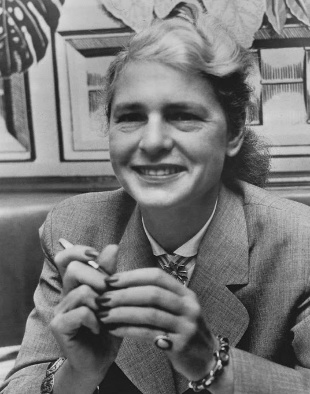Margaret Bourke-White (1904 - 1971) was a breakthrough photojournalist who took her first photography class in college. In a largely male-dominated profession, she made her mark as the first woman to photograph for LIFE magazine, the first accredited female war photographer in World War II, and the first Western photographer allowed into the Soviet Union to take pictures of industry there.
Bourke-White said of her profession: "I feel that utter truth is essential, and to get that truth may take a lot of seeking." Her restlessness and yearning for adventure took her around the world, first doing industrial photographs and then working as an associate editor and staff photographer at Fortune. Bourke-White earned her reputation as "the swashbuckling photojournalist" by being torpedoed in the Mediteranean and enduring the bombing of Moscow during the siege of the city. She was shocked when she visited Buchenwald on a tour of Germany, and was in India where she photographed Mahatma Gandhi hours before he was assassinated. She took some of the most poignant and horrifying photographs of the violence that erupted upon the partition of India and Pakistan.
When Margaret Bourke-White died in 1971, her friend Alfred Eisenstadt said of her: "She was great because there was no assignment, no picture that was unimportant to her." It is that ethical perspective that made her such a remarkable photojournalist.
To Name This Day . . .
 Quotes
Quotes
Here are some quotations from Margaret Bourke-White about photography. After reflecting upon her view of this art from, see how you might incorporate one of her views into some pictures you take today.
"Photography is a very subtle thing. You must let the camera take you by the hand, as it were, and lead you into your subject."
"If you want to photograph a man spinning, give some thought to why he spins. Understanding for a photographer is as important as the equipment he uses."
"As photographers, we live through things so swiftly. All our experience and training is focused toward snatching off the highlights. . . . That all significant perfect moment, so essential to capture, is often highly perishable."
"The very secret of life for me was to maintain in the midst of rushing events an inner tranquility. I had picked a life that dealt with excitement, tragedy, mass calamities, human triumphs, and suffering. To throw my whole self into recording and attempting to understand these things, I needed an inner serenity as a kind of balance."
 Spiritual Practice
Spiritual Practice
Spend some time today looking at photographs by Margaret Bourne-White. There is a good collection of them at Google Arts & Culture; you can find others in online galleries and museums. Here are two ways to deepen your encounters with the photographs.
1. Identify the benefits you experience from looking at the world through Margaret Bourke-White's eyes. Here are a few things a photograph can do:
- It directs our attention to the extraordinary in the ordinary.
- It enables us to see and appreciate the connections between people, animals, plants, places and things.
- It draws out our empathy and compassion in the face of suffering.
- It respects the mystery of all things and, in so doing, paves the way for a reverence of life.
2. Practice Visio Divina with one of the photographs. (Visio Divina is similar to Lectio Divina or Sacred Reading, but instead of working with a text to discover its meaning to you, you work with an image.) Here are the steps:
- Look closely at the photograph. What do you notice about it? Does some aspect of it stand out for you? A shape, its construction, a particular figure, etc.
- Narrow your gaze to what you noticed. Be attentive to what speaks to your heart as you reflect upon that part of the photograph. Ask yourself, "What is this picture telling me?" Or "Where is the sacred in this picture?"
- Respond to the photograph. What does it call forth from you? A prayer, words on a notepad, a drawing, a commitment to an action?
- Just sit with the photograph until you feel you have gotten what you need from your encounter with it.
